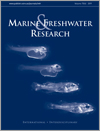Marine and Freshwater Research
Volume 70
Number 4 2019
Different populations vary in their response to climate change and this variation is fundamental to the long-term persistence of species. Here, we show how Murray cod larvae from different regions in Australia have different growth and survival responses to hot water temperatures (>26°C). This study is a novel example of how maintaining biological diversity among populations is important to ensure the resilience of species threatened by climate change.
Extensive swards of Phragmites australis occurred around the Gippsland Lakes in the mid-19th century but many had been lost by the mid-20th century, putatively because of increasing salinity. Field observations and growth trials suggest that salt-tolerant strains of P. australis have been selected for over the past ~50 years.
This study investigated the hydrological requirements (rainfall, depth and duration of flooding) of nitre goosefoot. Nitre goosefoot plants survived flooding, providing plants were not totally submerged, and leaf production, biomass and seeding increased during flooding and following flood recession. These results suggest that the hydrological requirements of nitre goosefoot should be considered in environmental watering programs.
A field study in Yasu and Ado River watersheds, Japan, showed that α and β diversity of benthic macroinvertebrates varied spatially in response to human-caused habitat transformation. The important environmental variables affecting the α and β diversity were different. Accordingly, intermediately disturbed habitats may benefit species turnover, and linking biodiversity and environments can provide information for conservation at the watershed scale.
Sinkhole water chemistry in the karst aquifer of the Ring of Sinkholes hydrogeological reserve area is controlled by carbonate rock dissolution, with dominance of Ca2+, Mg2+ and HCO3–. The absence of seawater intrusion was established. The sequential extraction procedure results confirm that sinkholes sediments acts as a sink of trace elements. Oxidative conditions, decreases in pH and ion composition are factors controlling trace elements in the sediments.
Coastal algal assemblages in south-eastern Australia are under threat, but we know little of the diet of abundant herbivorous fish. This study of the common rock cale revealed that, although juveniles consumed digestible filamentous algae, adults consumed structurally defended brown and calcareous algae. This highlights the complexity of trophic interactions and the potential for a variable response to algal loss across different life stages.
We investigated aquatic-to-terrestrial fluxes of emergent aquatic insects and shoreline orb-weaving spiders in a subtropical Florida estuary. Densities, community composition and functional traits of emergent insects varied seasonally and across low- to high-salinity sites. Spider densities were linked to emergent insect density at low- and mid-salinity sites, but this relationship was decoupled at high-salinity sites. Our findings contribute to our understanding of aquatic insect communities in estuarine ecosystems.
The importance of aquatic invertebrates in plant decomposition has been well documented. However, little information is available regarding the relative importance of micro-, meio- and macroinvertebrates in this process, particularly their role in the decomposition of buried organic matter. This study reveals the important but underestimated role of micro- and meioinvertebrates in macrophyte decomposition.
Land-use change substantially influenced invertebrate assemblages of streams across 6° of latitude in the Great Barrier Reef catchment, north-eastern Australia. Human influences included cropping, grazing, riparian vegetation loss and, locally, mining and distillery waste. Accounting for environmental gradients and using several disturbance measures at local scales improved identification of impacts. Riparian rehabilitation of catchments would greatly mitigate impacts.
The body-size spectra of the periphytic ciliates varied significantly among the four water depths. The dominant body-size units and trophic functional groups showed a significant vertical succession from 1 to 5 m. Body-size diversity indices represented a clear variability among four water depths while pairwise distinctness of the body-size spectrum increasingly departed from the expected pattern form surface to deeper layer.
White piranhas were introduced in the Jequitinhonha River basin and increased the incidence of mutilation on netted fishes. This species preferentially grazed on caudal fins from large fishes, without, in most cases, killing its prey. Interestingly, white piranhas avoided cannibalism, and, as its abundance increased, so did the number of species being preferentially grazed.
Landscape regions (ecoregions) and stream types were used to determine classes to reduce natural environmental and biological variation in a Brazilian river basin. We found that delimiting ecoregions by mapped information, followed by defining stream types from environmental data collected at stream sites, explained macroinvertebrate assemblage variation better than either alone. In addition, we determined indicator taxa for each of the resulting three stream classes.
Marlin research has been challenging because of poor conventional tag returns and high shedding rates of satellite pop-up tags. We surgically implanted archival tags into striped marlin while applying conventional tags at the same time, resulting in a 10% recovery rate of archival tags and 0% recovery of conventional tags. Although all the archival tags failed within a few months, we were able to determine that archival tagging could markedly improve the pace of marlin research.





